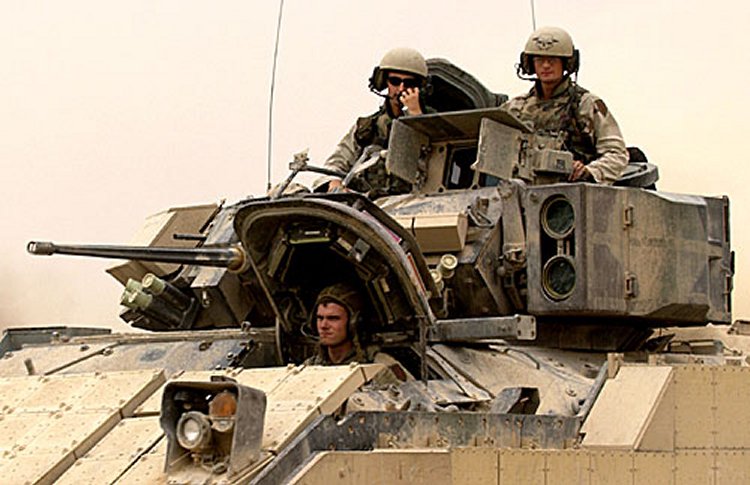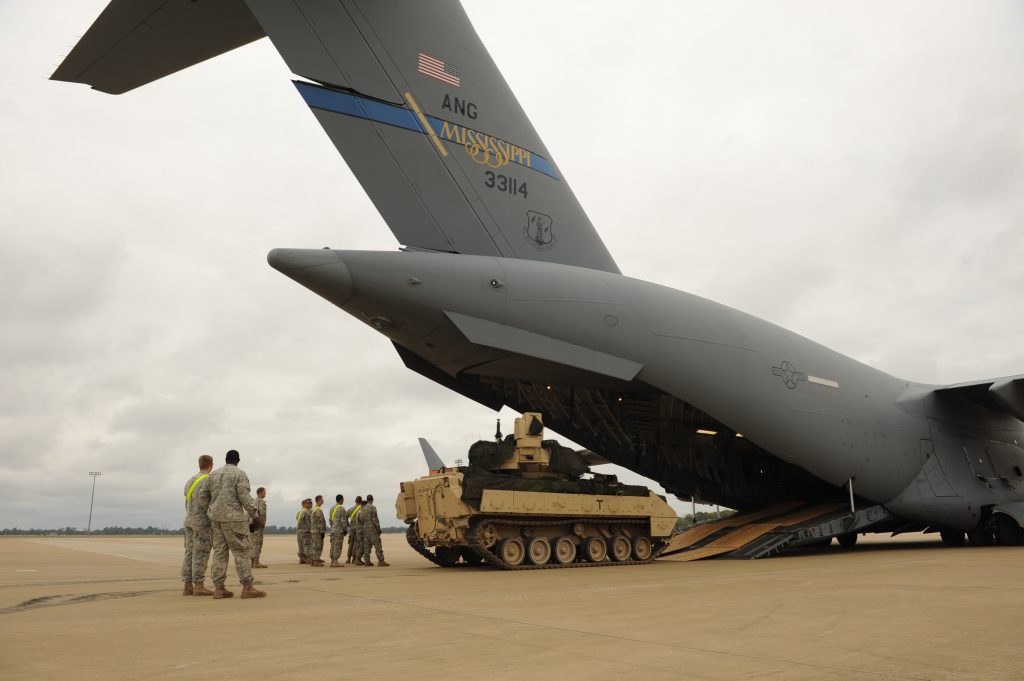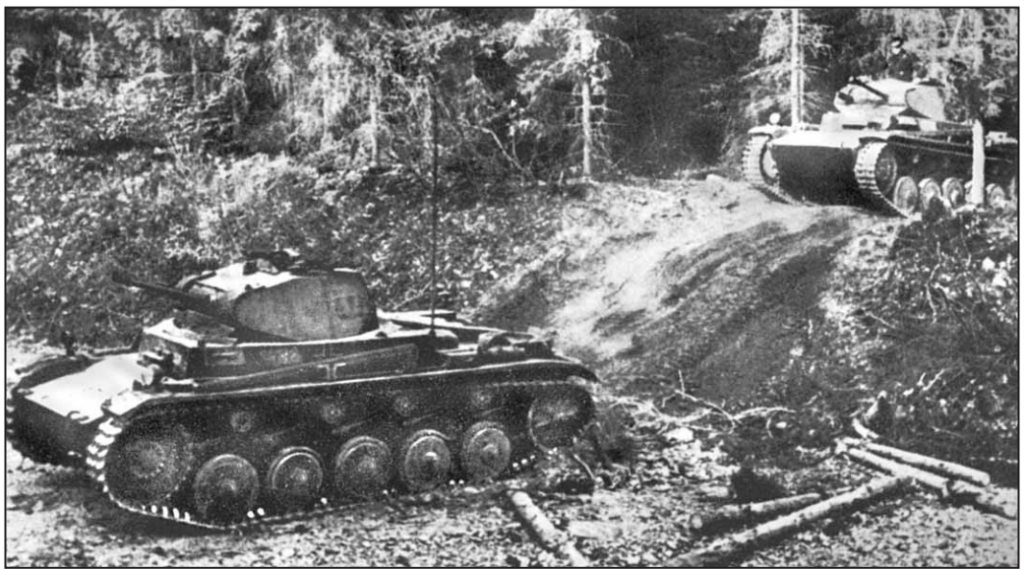
An M2 Bradley in Iraq, with all three crew visible: commander, gunner, and driver.
WASHINGTON: The Army is giving industry a lot of freedom in their designs for its future armored troop transport, letting them pick the gun, weight, number of passengers and more. But there’s one big exception. While the current M2 Bradley has three crew members – commander, gunner, and driver – a draft Request For Proposals released today says that its future replacement, the OMFV, must be able to fight with two.
Fewer humans means more automation. It’s an ambitious goal, especially for a program the Army already had to reboot and start over once.
The other fascinating wrinkle in the RFP is that the Army reserves the right to form its own design team and let it compete against the private-sector contractors. This government design team would be independent of any Army command to avoid conflicts of interest.
If the Army does submit its own design, that would be a major departure from longstanding Pentagon practice. But the Army has invested heavily in technologies from 50mm cannon to automated targeting algorithms to engines, so it’s not impossible for a government team to put all that government intellectual property together into a complete design.

The M2 Bradley has been repeatedly upgraded since its introduction, but after 40 years in service, the vehicle is reaching its limits.
The Army has embraced automation from the beginning of the Bradley replacement program, and that’s been consistent before and after January’s decision to reboot. OMFV’s very name, Optionally Manned Fighting Vehicle, refers to the service’s desire to have the option to operate the vehicle, in some situations, by remote control – eventually. But an unmanned mode remains an aspiration for future upgrades, not a hard-and-fast requirement for the initial version of the vehicle scheduled to enter service in 2028.
By contrast, the two-person crew is one of the few hard-and-fast requirements in the draft RFP released this morning. It’s all the more remarkable because there few such requirements in the RFP or its extensive technical annexes (which are not public). Instead, in most cases, the Army lays out the broad performance characteristics it desires and gives industry a lot of leeway in how to achieve them.
That’s a deliberate departure from traditional weapons programs, which lay out a long and detailed list of technical requirements. But the Army tried that prescriptive approach on OMFV and it didn’t work.

An Army M2 Bradley drives aboard an Air National Guard C-17 transport.
Last year, in its first attempt to build the OMFV, the Army insisted that industry build – at its own expense – a prototype light enough that you could fit two on an Air Force C-17 transport, yet it had to be tough enough to survive a fight with Russian mechanized units in Eastern Europe. Only one company, General Dynamics, even tried to deliver a vehicle built to that specification and the Army decided they didn’t succeed.
So the Army started over. It decided heavy armor was more important than air transportability, so it dropped the requirement to fit two OMFVs on a single C-17; now it’ll be satisfied if a C-17 can carry one. In fact, it decided rigid technical requirements were a bad idea in general because it limited industry’s opportunity to offer ingenious new solutions to the Army’s problems, so the service replaced them wherever it could with broadly defined goals called characteristics.
And yet the new draft RFP does include a strict and technologically ambitious requirement: the two-person crew.
Now, since the OMFV is a transport, it’ll have more people aboard much of the time, and when an infantry squad is embarked, one of them will have access to the vehicle’s sensors and be able to assist the crew. But when the passengers get out to fight on foot, there’ll just be two people left to operate the vehicle.
A two-person crew isn’t just a departure from the Bradley. This is a departure from best practice in armored vehicle design dating back to World War II. In 1940, when Germany invaded France, the French actually had more tanks, including some much better armed and armored than most German machines. But a lot of the French tanks had two-man crews. There was a driver, seated in the hull, and a single harried soldier in the turret who had to spot the enemy, aim the gun, and load the ammunition. By contrast, most German tanks split those tasks among three men – a commander, a gunner, and a loader – which meant they consistently outmaneuvered and outfought the overburdened French tankers.

German Panzers cross the Ardennes to take French forces by surprise, 1940.
A lot of modern vehicles don’t need a loader, because a mechanical feed reloads automatically. But in everything from the Bradley to Soviet tanks, the minimum crew is three: driver, gunner, and commander. That way the driver can focus on the terrain ahead, the gunner can focus on the target currently in his sights, and the commander can watch for danger in all directions. A two-person crew can’t split tasks that way, risking cognitive overload – which means a greater risk that no one spots a threat until it’s too late.
So how do fighter jets and combat helicopters survive, since most of them have one or two crew at most? The answer is extensive training and expensive technology. If the Army wants a two-person crew in its OMFV, the crew compartment may have to look less like a Bradley and more like an Apache gunship, with weapons automatically pointing wherever the operator looks. The Army’s even developing a robotic targeting assistant called ATLAS, which spots potential targets on its sensors, decides the biggest threat and automatically brings the gun to bear – but only fires if a human operator gives the order.
Now, industry does not have to solve these problems right away. The current document is a draft Request For Proposals, meaning that the Army is seeking feedback from interested companies. If enough potential competitors say the two-man crew is too hard, the Army might drop that requirement. The current schedule gives the Army about nine months, until April 2021, to come out with the final RFP, and only then do companies have to submit their preliminary concepts for the vehicle. The Army will pick several companies to develop “initial digital designs” – detailed computer models of the proposed vehicle – and then refine those designs. Physical prototypes won’t enter testing until 2025, with the winning design entering production in 2027 for delivery to combat units the next year.
Move over FARA: General Atomics pitching new Gray Eagle version for armed scout mission
General Atomics will also showcase its Mojave demonstrator for the first time during the Army Aviation Association of America conference in Denver, a company spokesman said.


























